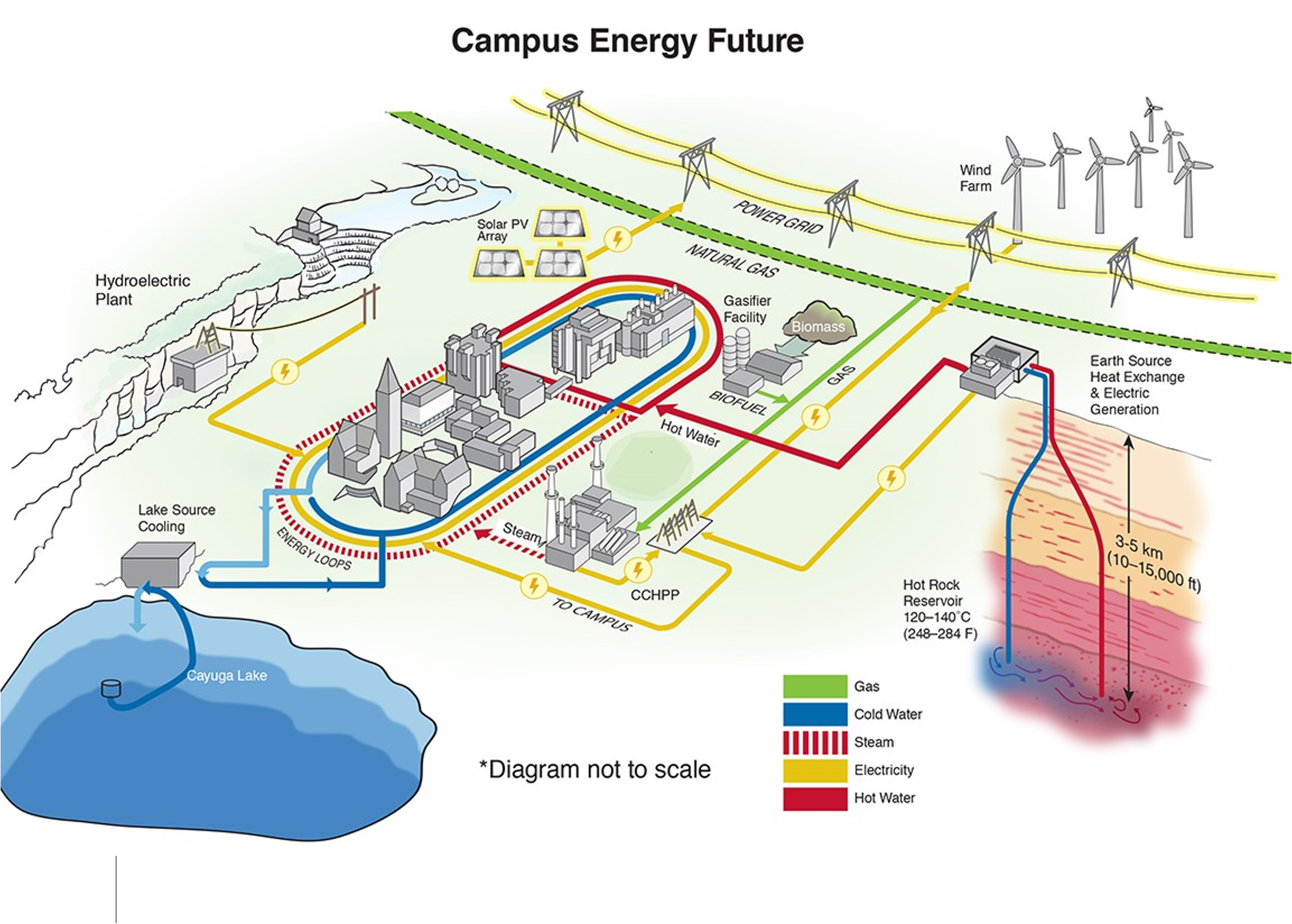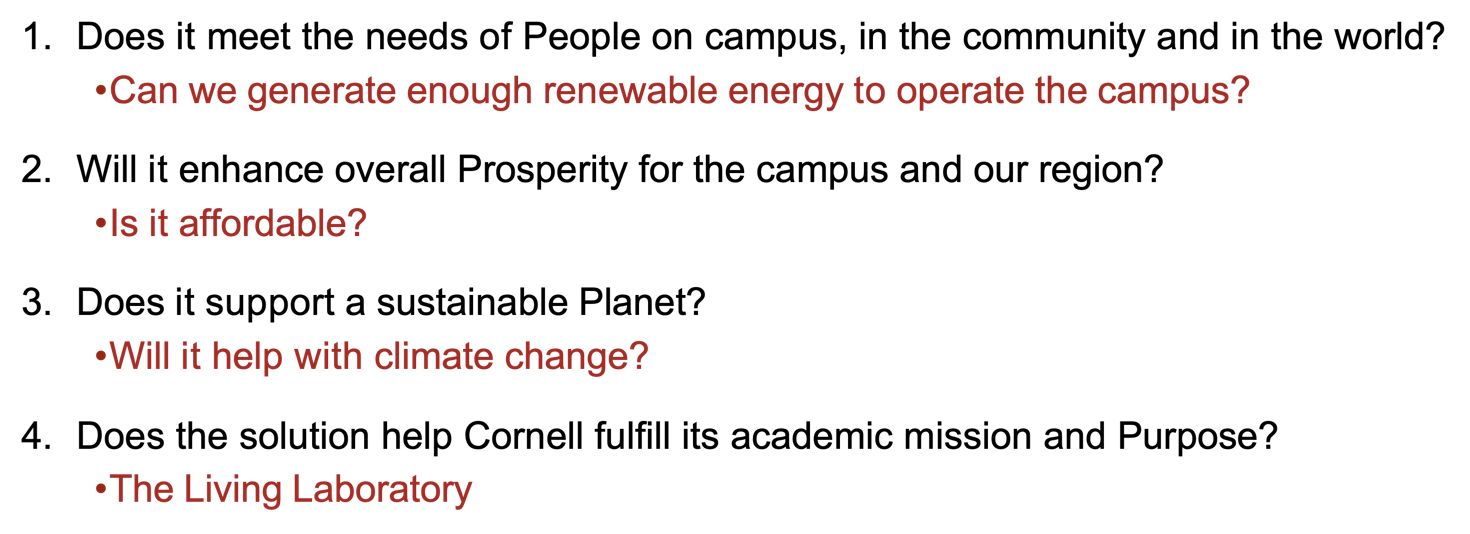4) Cornell Goal of Achieving Carbon Neutrality by 2035
1/19
There's no tags or description
Looks like no tags are added yet.
Name | Mastery | Learn | Test | Matching | Spaced |
|---|
No study sessions yet.
20 Terms
When/what started Cornell activism?
2001 Kyoto Now! Student Org protest in Day Hall. In 3 days, President Hunter Rawlings agreed to decrease Cornell carbon emissions with Kyoto protocol.
What was the first university in the US to commit to Kyoto protocol emission reductions?
Cornell
Sustainable Cornell Council (SCC) has 3 steering committees - what do each do?
Carbon Neutral Campus Committee
Campus Operations Committee
Education and Engagement Committee

5 sources of Cornell campus energy future
water (have a hydroelectric plant)
solar
wind
lake source cooling in summer est 2000
earth source heating in winter (bring water 3-5 km down, take heat up) - ?

Summary - options for heat/electricity supply
Heating
Earth-Source Heat (ESH): uses deep earth source (4-6 km)
Ground-Source Heat Pump (GSHP): uses shallow ground source (400-500 feet)
Air Source Heat Pump (ASHP)
Biomass Combustion: to generate heat during peak loads
Electric - Wind, Water, and Solar
What has alr been done in cornell?
15 solar arrays and a hydropower plant provide 100% renewable electricity on sunny days, all year
Lake Source Cooling provides 100% fossil-fuel-free renewable cooling to campus from Cayuga Lake
28 green buildings, including 5 LEED Platinum Buildings with green roofing and solar arrays
Grounds staff use a mobile solar trailer to power fossil-fuel free landscaping equipment
2022- CUBO(Borehole observatory) test well completed summer, revised climate action plan to include new energy pathways foreword
Net onsite CO2 emissions reduced by ___% since ___
42% since 2008
Emissions accounting Scopes
scope 1 - how much CO2 - burning natural gas at campus power plant? (use natural gas burnt amount )
scope 2 - how much coal/natural gas/hydroelectric, etc did you buy in another power plant?
scope 3 - external associated emissions - transportation/buses etc (hardest to count)
Cornell 2035 climate action plan started bcuz
students raised their voices in 2001 for social justice/future
Cornell GHG inventories - Cornell committed to accounting for upstream additions of greenhouse gases from 2 sources
methane leaked into atmosphere from fracking and
transportation of natural gas (from Pennsylvania to Cornell power plant)
Upstream methane leakage is between ___K and ___ K metric tons of CO2 equivalents added to the atmosphere via upstream transport and transport
50K and 160 K metric tons of CO2 equivalents (CO2e)
160 K metric tons of Co2 equivalents from methane leaked upstream would …
almost double our GHG emissions.
Pros/cons of additional GHG Inventories
PRO - when we reduce onsite emissions, we reduce leaked methane as well
CON - Cornell has a large shadow upstream methane problem
until the natural gas power plant is shut down and replaced with a completely renewable source of heat and electricity
Earth Source Heat Project Video
Cornell plan to use deep geothermal energy - find rocks underwater and drill to get heat with the borehole
use waste biomass from cornell cow and food waste on campas to convert into reneweable system
Cornell Uni Borehole Observatory (CUBO) info
made Summer 2022, drilled 2 miles deep with temperature 75-100 C at depth
CUBO Native Rock Permeability at Depth
Low permeability
Need hydraulic fracturing of rock to enhance existing water/heat transport between a pair of wells
permeability and connectivity of preexisting cracks in rocks similar to Cornell’s can be increased in a safe way so they can act as water pathways between wells!
Costs
accounting for methane leakage and offsetts of ancillary damages of CO2, business as usual is much more expensive than switching to earth source heat.
$71(heat/power solutions)< $85(usual) annually
Bottom Line sustainability decision making
most important point is - Does the solution help Cornell fulfill its academic mission and Purpose? The Living Laboratory

Carbon Neutrality by 2035 - Courageous Leadership
July 20th 1969 Apollo 11- JFK speech in 1961
Issues Remaining in Cornell
1. reduce upstream methane emissions created by using fracked natural gas to generate electricity and heat on campus.
2. Finding additional ways to get students involved with learning from “The Living Laboratory”
3. Improve climate change literacy among all Cornell students
Cornell tradition of doing the socially just thing first